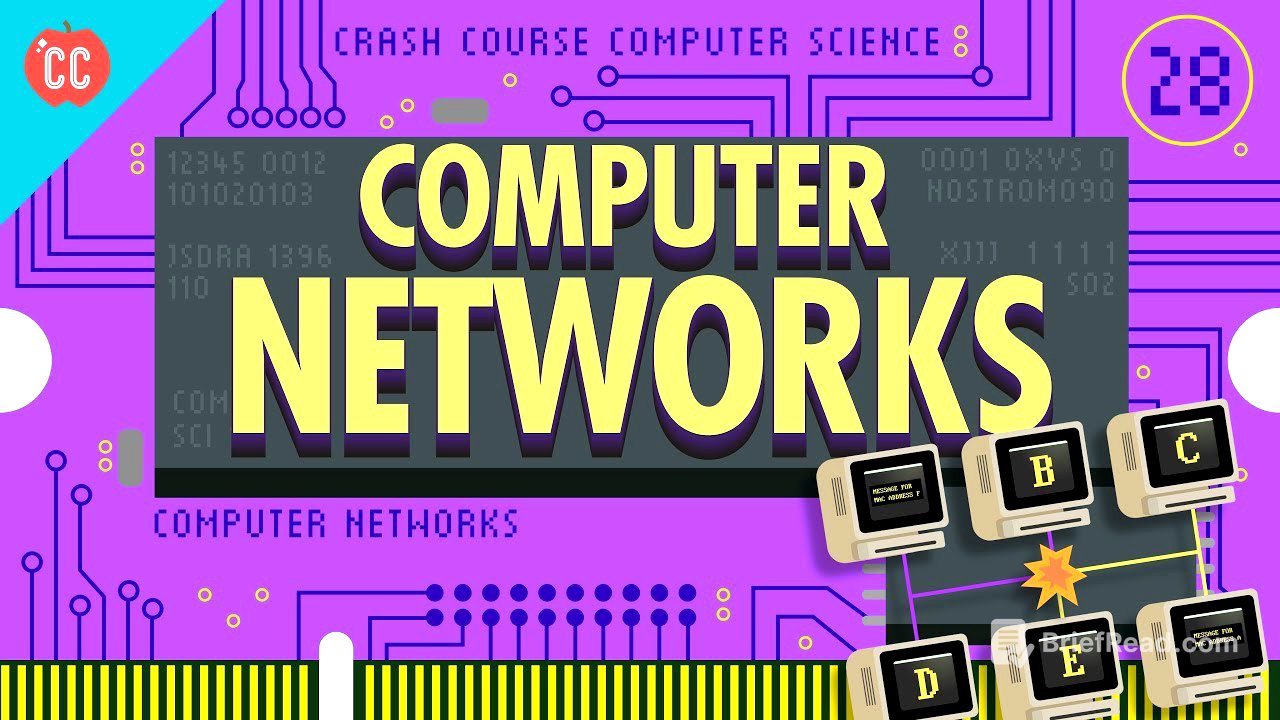TLDR;
This episode of Crash Course Computer Science provides an overview of computer networks, starting with their origins and evolution. It covers Local Area Networks (LANs) and Ethernet, including how computers use MAC addresses to manage data transmission and avoid collisions using Carrier Sense Multiple Access (CSMA) and Exponential Backoff. The discussion moves to larger networks, explaining routing methods like Circuit Switching, Message Switching, and Packet Switching, which is the foundation of the modern internet. The video also touches on the development of the ARPANET and the current state of the internet with billions of connected devices.
- Computer networks evolved from simple LANs to the vast internet.
- Ethernet uses MAC addresses and CSMA to manage data transmission and avoid collisions.
- Packet Switching, developed during the Cold War, is the foundation of the modern internet.
Introduction [0:03]
The internet has revolutionized global communication, enabling near-instantaneous information transfer. While computers initially operated independently, the need to share data and resources led to the development of computer networks. This video introduces a three-part series on the history, principles, and technologies behind computer networks.
Local Area Networks (LANs) and Ethernet [1:17]
The first computer networks, known as Local Area Networks (LANs), emerged in the 1950s and 60s to facilitate information exchange within organizations. Ethernet, developed in the early 1970s, became the most successful LAN technology. Ethernet connects computers via a shared cable, where each computer transmits data as electrical signals. To ensure data reaches the correct destination, each computer has a unique Media Access Control (MAC) address included in the data header.
Carrier Sense Multiple Access (CSMA) and Collision Avoidance [2:55]
Ethernet uses Carrier Sense Multiple Access (CSMA), where computers listen to the shared transmission medium before sending data. The bandwidth of the carrier determines the data transmission rate. Collisions occur when multiple computers transmit data simultaneously, garbling the data. To resolve this, Ethernet employs Exponential Backoff: computers wait a random period before re-transmitting, with the wait time increasing after each collision to reduce network congestion.
Network Switches and Collision Domains [5:24]
To improve network efficiency and reduce collisions, the number of devices on a shared carrier, known as the Collision Domain, must be reduced. Network Switches split a network into smaller collision domains, forwarding data only when necessary. Switches maintain a list of MAC addresses to determine which network segment a device is on, allowing simultaneous transmissions between different segments.
Routing Methods: Circuit Switching and Message Switching [6:27]
Routing involves finding the best path for data to travel between distant computers or networks. Circuit Switching, used in early telephone systems, allocates a dedicated communication line for exclusive use, which is inflexible and expensive but provides full capacity. Message Switching, similar to the postal system, passes messages through several stops, using different routes for reliability. Each stop uses a table to determine the next destination, and the hop count tracks the number of stops to identify routing problems.
Packet Switching and the Internet Protocol (IP) [9:12]
To address the limitations of Message Switching, large transmissions are divided into small packets, each containing a destination address. The Internet Protocol (IP) defines this format, assigning every connected computer an IP Address. Network routers balance the load across routes to ensure speedy and reliable delivery through congestion control. Protocols like TCP/IP handle out-of-order packets. Packet Switching is efficient, fault-tolerant, and decentralized, forming the foundation of the modern internet.
ARPANET and the Modern Internet [10:46]
Packet switching was developed during the Cold War due to the threat of nuclear attack. The ARPANET, funded by the US Advanced Research Projects Agency, was the world's first packet-switched network and the ancestor of the modern internet. Today, the internet connects billions of devices, including smart appliances, forming an "internet of things."
